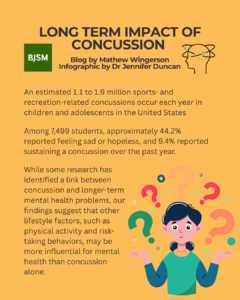Key words: Brain Injury, Physical Activity, Adolescence
An estimated 1.1 to 1.9 million sports- and recreation-related concussions occur each year in children and adolescents in the United States (1). Diagnosis, prognosis, and rehabilitation for concussion have progressed substantially over the past two decades (2). Despite this, patients, families, and clinicians are often left with one lingering question: how might this injury affect me in the long run? To help clinicians better address this complex concern, our study examined the link between concussion and mental health outcomes in United States high school students [link].
Why is this study important?
Past research has shown that negative mental health effects, such as increased symptoms of depression, are common for most patients following concussion but are generally considered transient and expected to resolve alongside other post-concussion symptoms (e.g., headache, dizziness) (3). However, some studies have identified a subset of patients who experience persistent mental health challenges for months post-concussion (4). A better understanding of the longer term impact of concussion on mental health is needed to set clearer expectations for patients and families regarding recovery and to identify strategies that may support well-being in the weeks and months after injury.
How did the study go about this?
We used a publicly available dataset [link] from the Centers for Disease Control and Prevention (CDC) in the United States. This dataset came from the Adolescent Behavior and Experiences Survey (ABES), a nationally representative survey assessing health and behaviour-related outcomes in >7,700 high school students (secondary school, ages 13 to 18). Participants answered questions about mental health, including whether they had experienced feelings of sadness or hopelessness in the past month, and reported if they had sustained a concussion in the last year. The survey also assessed various risk-taking behaviours, including substance use (e.g., drugs, alcohol) and typical frequency of engaging in physical activity. Our goal was to examine if any of these factors were associated with feelings of sadness or hopelessness in this sample of high school students.
What did the study find?
Among 7,499 students, approximately 44.2% reported feeling sad or hopeless, and 9.4% reported sustaining a concussion over the past year. After adjusting for factors such as physical activity frequency and substance use, we found that students who sustained a concussion in the past year were no more likely to report sadness or hopelessness than students who did not. However, engaging in more days of physical activity each week and abstaining from substance use were associated with a lower likelihood of reporting sadness or hopelessness. These findings suggest that, regardless of sustaining a concussion, more physical activity and less illicit substance use are strategies to reduce the likelihood of feeling sad or hopeless for adolescents.
What are the key take-home points?
While some research has identified a link between concussion and longer-term mental health problems, our findings suggest that other lifestyle factors, such as physical activity and risk-taking behaviors, may be more influential for mental health than concussion alone. However, these relationships are complex and multifactorial.
This study is one example of research investigating how concussion and mental health are associated within the context of broader health-promoting behaviors. It is important to consider other lifestyle factors when assessing a patient’s long-term health after concussion, and clinicians may choose to emphasize the importance of healthy lifestyle decisions when addressing patient and family concerns about the long-term effect of concussion.
Publicly available datasets, developed through rigorous national research organizations (e.g., CDC), are essential for continued progress in healthcare. Research of this type, including our study, rely on tremendous efforts from these institutions to ensure rigor and reproducibility. The insights gained from publicly available datasets help inform clinicians, guide patient care, and empower families with evidence-based knowledge about concussion recovery. Support for agencies like the CDC allows for large-scale research that directly benefits public health, and ensures patients and clinicians have access to high-quality, data-driven information.

Author: Mathew Wingerson & David Howell
References:
- Bryan MA, Rowhani-Rahbar A, Comstock RD, Rivara F; Seattle Sports Concussion Research Collaborative. Sports- and Recreation-Related Concussions in US Youth. Pediatrics. 2016 Jul;138(1):e20154635. doi: 10.1542/peds.2015-4635. Epub 2016 Jun 20. PMID: 27325635.
- Patricios JS, Schneider KJ, Dvorak J, Ahmed OH, Blauwet C, Cantu RC, Davis GA, Echemendia RJ, Makdissi M, McNamee M, Broglio S, Emery CA, Feddermann-Demont N, Fuller GW, Giza CC, Guskiewicz KM, Hainline B, Iverson GL, Kutcher JS, Leddy JJ, Maddocks D, Manley G, McCrea M, Purcell LK, Putukian M, Sato H, Tuominen MP, Turner M, Yeates KO, Herring SA, Meeuwisse W. Consensus statement on concussion in sport: the 6th International Conference on Concussion in Sport-Amsterdam, October 2022. Br J Sports Med. 2023 Jun;57(11):695-711. doi: 10.1136/bjsports-2023-106898. PMID: 37316210.
- Fish AM, Vanni J, Mohammed FN, Fedonni D, Metzger KB, Shoop J, Master CL, Arbogast KB, McDonald CC. Comparison of Anxiety and Depression Symptoms in Concussed and Nonconcussed Adolescents. Sports Health. 2023 Mar-Apr;15(2):185-191. doi: 10.1177/19417381221113840. Epub 2022 Aug 2. PMID: 35919017; PMCID: PMC9950990.
- Yang MN, Clements-Nolle K, Parrish B, Yang W. Adolescent Concussion and Mental Health Outcomes: A Population-based Study. Am J Health Behav. 2019 Mar 1;43(2):258-265. doi: 10.5993/AJHB.43.2.3. PMID: 30808466.